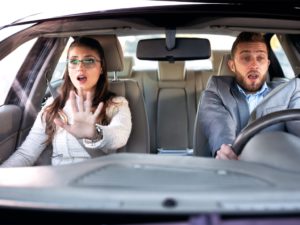How in the World Can a Phantom Vehicle Be Liable for Your Injuries?
Posted April 30th, 2019 by Anthony Carbone, PC.
Categories: Auto Accidents.
 What does the word phantom mean to you? Does it conjure up thoughts of an immortal superhero? Or, of the clandestine character in a Broadway musical? In either case, you might be confused. How could a phantom vehicle possibly be liable for your injuries?
What does the word phantom mean to you? Does it conjure up thoughts of an immortal superhero? Or, of the clandestine character in a Broadway musical? In either case, you might be confused. How could a phantom vehicle possibly be liable for your injuries?
For starters, it might help to understand the concept of a phantom vehicle. Perhaps the best way to get a basic understanding comes from a New Jersey Supreme court case. Krzykalski v. Tindall was decided in 2018 and represents the seminal case on the issue of negligence and phantom vehicles.
According to the case history, Mark Krzykalski suffered injuries as a result of a car crash. As Mark drove in the left lane traveling north, David Tindall’s rear-ended him. However, it was the circumstances leading to the accident that proved critical to this case. As it turns out, a motor vehicle operated by an unknown individual came from the right lane and decided to make a left turn. The legal papers refer to this driver as a John Doe defendant, and the law considers that car a phantom vehicle.
- When Mark’s car was cut off, he was unable to stop his vehicle in time. As a result, he crashed into the car in front of him. The sudden stop placed David in the same position and contributed to the reason he rear-ended Mark’s vehicle.
- Ultimately, the court apportioned liability for the accident using a theory of comparative negligence. While David bore some responsibility for failing to stop his vehicle, John Doe played a role in the crash that caused Mark’s injuries. The Supreme Court found that operators of phantom vehicles may be apportioned fault for their actions leading to auto accidents.
New Case Deals with Phantom Vehicle
 Just a week ago, the New Jersey Appellate Division considered another case involving a phantom vehicle. The matter of Medway v. Encompass Ins. Co. went to the New Jersey Appellate Division on the issue of damages only. In case you’re uncertain as to what constitutes damages for personal injuries, you may want to read this article. It essentially translates to what determines compensation for the harm you suffered as a result of another person’s negligence.
Just a week ago, the New Jersey Appellate Division considered another case involving a phantom vehicle. The matter of Medway v. Encompass Ins. Co. went to the New Jersey Appellate Division on the issue of damages only. In case you’re uncertain as to what constitutes damages for personal injuries, you may want to read this article. It essentially translates to what determines compensation for the harm you suffered as a result of another person’s negligence.
Meanwhile, you should know that the trial court found that a phantom driver was 100% negligent for an automobile crash. In this case, Samuel Medway described the circumstances that led to her injuries. The jury found Samuel’s testimony to be credible when the case was tried in Superior Court. According to him, he was driving on the Garden State Parkway and noticed a phantom vehicle tailgating him.
Ultimately, that same driver sped up and cut off Samuel’s car and hit the front right-hand side of the vehicle. Samuel slammed on his brakes, and the two vehicles began to swerve. In the end, the plaintiff suffered injuries when he crashed into the guardrail. At the time of the impact, Samuel estimated that he was traveling between 40-50 mph. The force of the collision caused the airbags to deploy. Fortunately, the plaintiff wore his seatbelt and was not thrown from the vehicle. Nonetheless, he suffered injuries.
- Samuel further testified that a woman approached him subsequent to the accident and apologized for cutting him off. However, he did not get her information before she drove away from the scene.
More on the Automobile Crash
 Although the police report documented that another car was involved in the car crash, the driver was not deposed nor did she testify at trial. The state trooper included the statement he obtained from the third driver on the police report. When the trooper testified in court, the trial judge ruled against him sharing the information provided by that driver. It constituted hearsay evidence.
Although the police report documented that another car was involved in the car crash, the driver was not deposed nor did she testify at trial. The state trooper included the statement he obtained from the third driver on the police report. When the trooper testified in court, the trial judge ruled against him sharing the information provided by that driver. It constituted hearsay evidence.
The jury considered the physical evidence also documented by the state trooper. Testimony included references to skid marks and an opinion regarding the damage to the plaintiff’s vehicle. They appeared to be “consistent with that of a sideswipe accident.” When the jury decided on the liability issue, in this case, they determined that the phantom driver was entirely responsible for the accident. The plaintiff originally received $25,000 for compensatory damages.
The plaintiff motioned for a retrial on the issue of damages alone. The second jury came back with a verdict of $350,000, which was appealed. You can read more about why the Appellate Division set aside the more significant verdict and ordered a new trial as far as the damages issues.
Who Pays Damages for Phantom Vehicle Accident Claims?
 In the meantime, you may wonder about one critical issue involving phantom vehicle accident claims. Who pays for damages when the findings show an unidentified driver caused the crash? You may not realize it, but your automobile insurance policy contains a section insuring you for uninsured/underinsured motorist claims. If you are involved in a hit and run accident or one concerning a phantom vehicle, your own insurance company provides coverage for your damages.
In the meantime, you may wonder about one critical issue involving phantom vehicle accident claims. Who pays for damages when the findings show an unidentified driver caused the crash? You may not realize it, but your automobile insurance policy contains a section insuring you for uninsured/underinsured motorist claims. If you are involved in a hit and run accident or one concerning a phantom vehicle, your own insurance company provides coverage for your damages.
Contact Us
All things considered, you may not realize that you can pursue a claim even when you can’t identify the driver. The Law Offices of Anthony Carbone represents personal injury victims for many types of accidents. We can help you seek recovery. Contact us at 201-829-3829 to schedule an appointment.


